Ris a la Mande is a traditional Danish Christmas dessert. Rikke gave us the recipe last December, and we’ve made it three times with some variations.
The name is derived from the French “riz à l’amande” which means “rice with almonds.”
Be careful – this is delicious. It’s great for kids, or anyone young at heart.
Ingredients
The first group of ingredients, which make a rice porridge, are:
- 125 g uncooked short grain (sushi) rice
- 1 liter (1 quart) milk
- 1 vanilla bean (or ¼ tsp vanilla extract)
- 1/4 tsp salt
A second group of ingredients, completing the dessert, are added later:
- 75 g (1/2 cup) almonds, skin removed (or macadamia or cashew nuts)
- 250 ml (1 cup) heavy cream
- 60 ml (¼ cup) rice syrup (or equivalent sweetener)
- fruit, berries, jam, or other topping
We tried a number of variations:
- Almonds, cashews, and macadamia nuts were all delicious;
- Vanilla extract was nearly as good as using a whole vanilla bean;
- Cranberries, pomegranate seeds, or other fruits and berries can substitute in part for the rice syrup, and add sour flavors (cranberries) or texture (pomegranate seeds)
Preparation
Soak the uncooked rice in water for 10 minutes and then rinse through a strainer. This will let the rice absorb some water to start, and rinse off any surface contaminants and some starch.
Place the rice in a pot, add milk and salt, split the vanilla bean and scrape out the seeds; add both seeds and pod to the rice and milk. Bring to a boil, turn down the heat and simmer for about 45 minutes. Stir once in a while to avoid burning.
Remove the vanilla pod and let the porridge cool.
Chop the nuts and whip the cream until stiff. However (“!IMPORTANT!” says Rikke) be sure to set one whole nut aside.
Fold the whipped cream and chopped nuts into the cooled porridge:
When thoroughly mixed it looks like this:
Sweeteners and Toppings
Add rice syrup or equivalent PHD-compatible sweetener to taste:
Rikke tells us that in Denmark Ris a la Mande is usually served with cherry sauce on top. We tried homemade cranberry sauce (for a sour taste) and pomegranate seeds:
I am sure a wide range of fruits, berries, or flavors would taste great. I liked the acidic taste from the cranberries, so I might recommend the meat and juice of a half lemon as another idea to consider.
The Extra Nut
Why was it important to set one nut aside? Rikke tells of a fun game:
In Denmark, it is tradition to put the whole almond in the big bowl containing all of the ris a la mande. People help themselves to a portion (or more…) of the ris a la mande, and the one who gets the whole almond gets a little present! It is common practice to hide from others if you have the almond, and enjoy watching everyone getting frustrated with not finding it! 🙂
In our house Shou-Ching has won every time, but I’m not suspicious (yet).
Not Just for Christmas
This might make a good refreshment during today’s big game: Puppy Bowl VIII on Animal Planet:








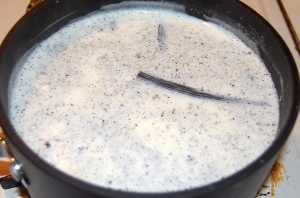
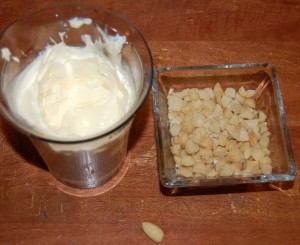
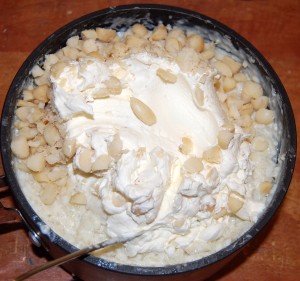
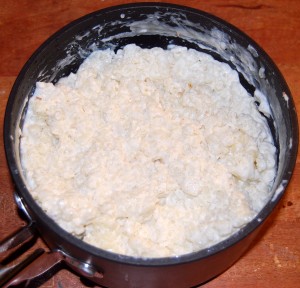
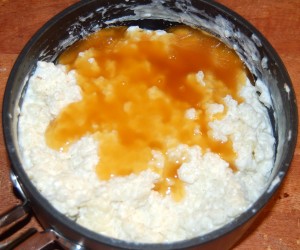





one of the best snack/dessert…Korean Ddeok!!!
Have you tried it?
Thanks for sharing.
Looks delicious. 🙂
Puppy Bowl VIII!! That’s my kind of contest.
As a Dane, I have to say this is one of my favourite desserts. Also, every time I’ve made it for people abroad, they’ve loved it as well!
Hi Stephanie,
We have it regularly, as a dessert or treat; we also use the white rice cake (http://en.wikipedia.org/wiki/Ddeok) in soup and other dishes. We used it in our Pesto recipe: http://perfecthealthdiet.com/?p=2899. You can buy the rice cakes pre-prepared. It’s not only Korean, Chinese and Japanese use rice cakes too. We may do a rice cake recipe sometime soon.
Best, Paul
What can I say… I’m honored!:D
Very happy you like it!
Paul – I want to acknowledge at the outset that my questions are wholly unrelated to the topic of today’s post. But, as a fairly regular reader of your blog, I know that you tend to reply to many posts, and so I was hoping I might get your response to this.
First off, I want to say that I have read and thorougly enjoyed your book (the Kindle version, by the way). And I have learned a great deal from it. Thank you for all of your hard work.
My question for you concerns the best way to eat to combat or prevent heart disease. As you are probably aware, some groups advocate an extremely low-fat, and oftentimes vegan, diet as the most effective tool in this regard. Examples of this are Dean Ornish and Caldwell Esselstyn. Their theories seem tied, at least in part, to the lipid hypothesis. But they nevertheless appear to be effective in improving lipid profiles. And, according to Ornish and Esselstyn, in actually reversing heart disease. In light of the discussion in your book of how the body converts certain substances into saturated fat, why do you think the low-fat and/or vegan diets are effective in terms of heart disease? Or do you question whether they are effective at all.
My related question concerns paleo diets in general, and PHD in particular. It seems common among paleo dieters to experience increases in total cholesterol. What do you think an ideal cholesterol profile should be, in terms of avoiding cardiovascular problems?
Thanks in advance for any response you might have. And thanks again for the book. It’s terrific.
Hi Troy,
I don’t think the low-fat diets are effective against heart disease, and I think if people stick with them for a long time they are likely to have trouble.
However, they may often be effective weight loss diets, and so for those with obesity / metabolic syndrome they may reduce heart disease risk, or at least some things associated with heart disease risk.
But there are better weight loss diets.
Overall, I think the Ornish and Esselstyn diets are very poor.
There are many posts on this site about cholesterol. Ideal profile: Total cholesterol, 200-240 mg/dl; HDL, >60 mg/dl; trigs, <80 mg/dl. LDL can cover a broad range consistent with health, but LDL numbers that are healthy in some people can be unhealthy in others, so I don't see it as having a well-defined "normal" range, but generally speaking 80 to 160 mg/dl can be consistent with good health.
I see blood lipids as having considerable diagnostic value for health problems, but not for the most part as causal factors in disease.
High LDL/TC on Paleo seems to result from eating too few carbs, being deficient in key minerals, or being hypothyroid. We haven't had any cases of high cholesterol developing while on PHD to my knowledge, and many people moving from low-carb Paleo diets have seen their lipid issues fixed.
Best, Paul
I love rice desserts and this rice pudding reminds me of the traditional Glutinous Black Rice Pudding that uses pandan leaf, coconut milk and coconut sugar and I make this once every month. I am going to try and make Ris a la Mande–it looks really good!
Wati,
That sounds like an equally addictive dessert. Love that version at Thai restaurants. I’d add some carmelized banana.
Paul and Shou-Ching,
Hope you are both doing well! We have done lots of experimenting with versions of bibim bop and will post soon (someday)! This looks delicious!! We’ve done something similiar with half Thai black rice which adds a nutty crunch. The nut idea adds some fun!!
Paul –
Thanks for your response. Could you say a bit more with regard to why you think the Ornish/Esselstyn diets are “poor”? Too low in total fat? Too many toxic foods (e.g., wheat, legumes, etc.)?
One other question. Although I have a family history of heart disease and am particularly concerned about using diet to lower my risk in that regard, I am not overweight. In fact, I am underweight and would like to add some lean muscle mass. Do you have any suggestions for how to go about that?
Thanks again Paul.
This looks delicious! I like the sound of the whipped cream folded in after cooking. I recieved a pressure cooker for christmas (makes OUTSTANDING bone broth in a fraction of the time, as well as many other PHD gourmet foods!) and I have been making a really good rice pudding in it in a matter of minutes. It would be easy to adjust with the almonds. The only problem is that it causes me to eat way too much! So I have had to stop…
Ris a la mande is my all time fav dessert. I’m Danish too, and we have it for christmas with cherrysauce, but I could eat it all year round.
I’m So gonna make some this week!
Hi Paul,
I am thinking the rationale for pasteurized milk and combining fruit with milk proteins is that this is a dessert and these are okay occasionally.
Thanks,
Mark
Hi Mark,
We’re more concerned about combining fruit with polyunsaturated fats than with proteins. Milk is low in polyunsaturated fat.
Hi Paul,
Oh, ok, how about the PHD book’s guidance to avoid pasteurized milk?
Thanks,
Mark
Hi Mark,
I do think unpasteurized, unhomogenized is better. But I do drink pasteurized, that’s what’s available. I’m hoping low-temperature pasteurization methods will spread. I’d also like to see raw milk legalized.
Do you consider pasteurization the more harmful process as opposed to homogenization? I’ve been assuming the reverse.
It’s hard to say Faisal. I don’t know. But pasteurization at least has some safety benefits.
Paul –
Regarding the advice in PHD to avoid combining PUFAs and fruit, would this apply to almond butter? I love almond butter, but probably consume too much of it. And I’m wondering if combining it with bananas, etc., is a no-no.
Thanks.
Hi Trey,
Almonds aren’t bad as far as omega-6 content, so it’s not that bad a practice. I wouldn’t worry about it, unless this becomes a staple of your diet.
Hey Paul I am curious if you have found rice syrup from white rice? I haven’t had any luck.. only found brown rice syrup.. I also have coconut palm syrup which is supposedly 90% sucrose and the rest fructose and glucose… is this a reasonable option?
Hi BS,
There was a company selling it on Amazon but I think they stopped. However, you can get tapioca syrup: http://www.amazon.com/Barry-Farm-Tapioca-Syrup-oz/dp/B000NQBZWS/
You can order it through the manufacturers site for anyone looking for a hookup.. shipping to Canada is pricy.. but probably worth it and probably not pricy to america.. http://www.barryfarm.com/sugars.htm
Tapioca Syrup is a safe starch option (the link is from the PHD supplements page). This one came to me in a plastic jug, as opposed to the pictured glass jar. Ingredients: Tapioca, water.
I haven’t had any luck finding it in Canada.. anyone have a clue where to get it in Canada?
Hi Paul, is it possible to make this dish using coconut milk or coconut cream instead? I cant tolerate dairy. Ive made tapioca pudding using coconut milk before so assume this is possible.
This rice pudding is fabulous…made it yesterday. Definitely satisfies my sweet tooth!
Trying to make this for Thanksgiving & can’t figure out how many cups is 125 grams of rice! Please help! How much rice in USA terms- cups?
Thanks! 🙂